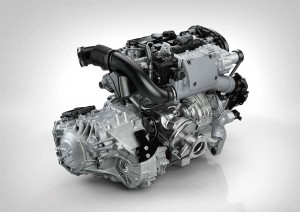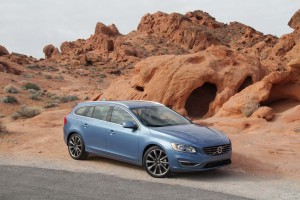Hoping to establish itself as a significant player in the global luxury car market, Volvo is making an $11 billion investment in new products and the plants to build them – an aggressive and much-needed plan that puts a particular premium on an all-new line-up of advanced powertrains that Volvo promises will deliver both segment-leading mileage and world-class performance.
The first of the maker’s models equipped with the new Drive-E engine family are just beginning to roll into U.S. showrooms this month – and they mark the beginning of the end of the relationship between the Swedish-based company and Ford Motor Co. that began when the Detroit maker purchased Volvo Cars in 1999.
But the powertrain program isn’t without its risks, Volvo officials acknowledge. Among other things, it will mean convincing upscale buyers who traditional equate displacement with desirability that a high-tech 4-cylinder engine can be as good, or better, than the six- and eight-cylinder powertrains that traditionally dominate the luxury market.
The goal is to create a family of “smaller, more intelligent engines that will turn the V -8 engine into a dinosaur,” proclaims Derek Crabb Volvo’s vice president of powertrain engineering.

The new Volvo Drive-E engines will be offered in a variety of configurations, including turbo and supercharge-boosted, as well as hybrid packages.
The broad investment program is being funded by Geely, the ambitious Chinese automaker that purchased Volvo in 2010 for a fraction of what Ford originally spent on the brand – never mind what it invested during a decade of ownership.
Volvo emerged from the alliance with some serious issues, sales hammered not only by the worldwide recession but by consumer concerns about some of its products. Geely CEO Li Shufu, intent on becoming a serious global player, has seen Volvo as both a way to expand his company’s presence outside China as well as a source of technical knowledge that has so far been difficult for Geely to develop in-house.
(Volvo Concept XC Coupe gives a glimpse of the Swedish maker’s future. Click Here for a closer look.)
The $11 billion authorized by the Chinese parent is funding, among other things, two new Volvo plants in China, including one that opened in Chengdu last year. Volvo has meanwhile worked up two new vehicle architectures, one for its smaller models, the second for larger vehicles such as the next-generation XC90.
These new products will start phasing in over the course of the decade and they will switch to the new Drive-E powertrains. But Volvo isn’t waiting until then to begin using these all-new engines, which are being produced at its powertrain plant in Skovde, Sweden which recently went through a $300 million expansion. They’ll be offered as part of the powertrain mix for the updated Volvo S60 sedan, V60 wagon and XC60 crossover, all three launching in the coming months as 2015 models.
(Volvo XC Coupe prototype wins concept design award at Detroit Auto Show. Click Here for the story.)
Volvo officials admit it can be confusing to explain their new powertrain line-up, especially while some older engines are still available. There’s the outgoing T6, a six-cylinder engine currently provided by former parent Ford, for example. It will be dropped by the end of 2015, ending Volvo’s dwindling ties to the U.S. maker.
But the name, T6 will remain in Volvo’s catalogue. More precisely, there’s a new T6 E-Drive engine that will actually only be an inline-four. It will make up for the lack of four cylinders by using an unusual combination of turbocharging and supercharging. The approach helps deliver both maximum launch torque and higher horsepower for cruising, explains Jan-Erik Larsson, Volvo’s senior powertrain manager.
The new T5 E-Drive will also have four cylinders, rather than the inline-five design of the old Volvo T5, but here it will use only a single turbocharger.
(Three Volvo models named among America’s safest vehicles by the IIHS. Click Here to find out which ones.)
So, why are the T5 and T6 designations carried over? Because they will now be used to represent the horsepower range of a given Drive-E engine type, a T6 delivering between 276 and 325 horsepower, the T5 a more modest 226 to 275 hp.
“We’re no longer talking about the amount of cylinders when we talk about power,” explained Joe Haslem, the U.S. product manager for the S60, V60 and XC60 models.
Volvo expects the new Drive-E engines alone to reduce fuel consumption by anywhere from 13 to 26% compared to its current powertrain lines. The displacement downsizing is one key factor, but the new engines will adopt direct injection and variable valve timing, along with other advanced features such as a new 8-speed automatic gearbox and Stop/Start which shuts off the engine rather than idling, automatically restarting when the driver’s foot lifts off the brake.
Going forward, Volvo might yet downsize these 2.0-liter packages and add a 1.5-liter configuration, suggests Larsson, a size that would have an advantage in markets such as China where vehicle taxes are tied to engine displacement.
But Volvo is adding battery-assisted versions of the E-Drive family such as the new plug-in hybrid it recently launched in Europe. A hybrid version of the next XC90, he hints, will opt for a so-called through-the-road all-wheel-drive system where the rear axle is powered exclusively by battery power.
While the Ford-derived six-cylinder T6 will be gone in less than two years, Volvo officials are hesitant to say how long the rest of the maker’s old engines will be around, but it won’t be long. They’ll be phased out as models based on the two new common vehicle architectures debut – which means sometime before the end of this decade.


VW built a nice series of supercharged and turbo charged engines that ran quite well but they are very expensive to produce, difficult to maintain and did not offer a fuel savings over just a turbo version. The supercharger compensates for turbo stumble on take off but it also has parasitic loss issues even with disengagement systems.
If Volvo owners like the E engines it might help sales but even with balance shaft technology, superchargers and turbos a four cylinder engine has coarser power delivery than a six or eight cylinder engine. That is a fact of life.
Hi, Jorge,
Volvo is claiming it has eliminated all parasitic losses with its clutch system. I’ll wait to dispute that until someone more engine tech savvy pulls one of these apart. As to ride smoothness and acceleration feel I have to say that the Drive-E engines are impressive, with none to minimal sense of any torque steer or other traditional turbo-based problems. We’ll have reviews up soon.
Paul A. Eisenstein
Publisher, TheDetroitBureau.com
Hopefully they have a package that buyers like. It’s always been tough to simulate the driving sensation of a torquey engine with fewer cyliners because of the cylinder firing spacing. That’s acceptable in entry level models but not so much in upscale luxury models.
Torque steer is primarily a function of FWD and can exist with or without a turbo or supercharger. They just tend to increase the problem. Eliminating torque steer on FWD vehicles is a real challenge as a lot depends on available traction so the situation can change in wet vs. dry, with the wheels turned vs. straight, etc.